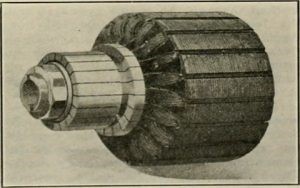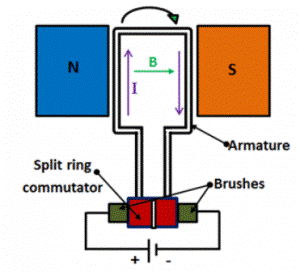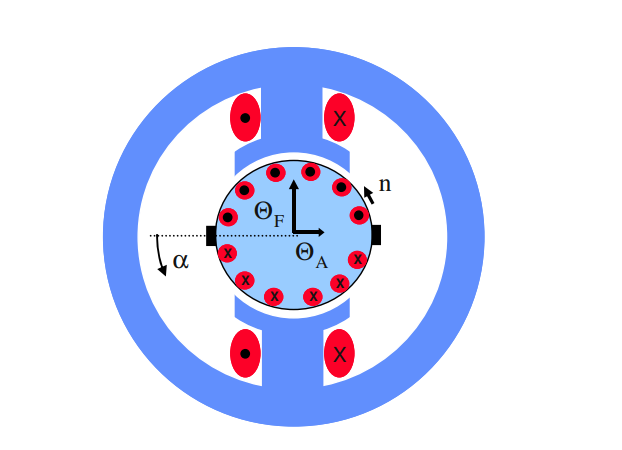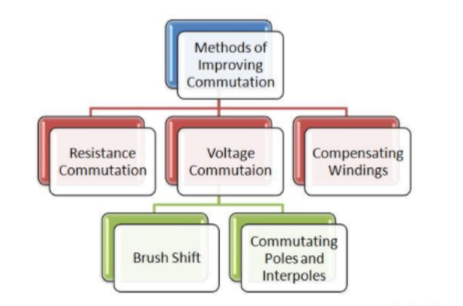Compensation in DC Machines, Essay Example
Background
Commonly, emf induced into the rotating conductor or winding is continuously alternating in nature. If the machine is of DC Generator then it is bounding for someone to convert it into a unidirectional emf. This progression of converting alternating current voltage into DC is usually identified as commutation. Hence, the commuter is a device that normally acts as a rectifier and performs the process of rectification. Coil current is continuous and unidirectional as long as the coil is underneath the effect of the given pole pair, while it converses when the coil accesses onto the succeeding pole pair as the armature interchanges. Commutation comes to pass when the coil is fleeting through the interpolar section and during this time the coil is shorted through the commutator sections by the brushes situated in the interpolar section. Commutation occurs concurrently for P coils in circuit wound machines and dualistic coil sets of P/2 coils apiece in a wave coiled machine.
Despite the fact that a huge percentage of electrical machines used in the industries are alternating current (A.C.), D.C. machines are still essential in several industrial applications because they offer a precise speed control not provided by any A.C. machine (Melkebeek, 2018). Two types of D.C. machine exist Generators and motors. Generators convert mechanical motion into electrical energy while motors convert electrical power into motion. Notably, the EMF generated by D.C. generators is an alternating one while the actual output is D.C. This conversion is achieved by a gadget referred to as a commutator (figure 1), which is considered a mechanical rectifier (Sahdev, 2017).

Figure 1: Commutator (“What is commutation in dc generator – methods used to improve it,” 2019)
The commutator has two segments separated by a thin sheet of mica. Two immobile brushes are attached to the commutator segments to direct current to the load. As the coil is rotated within a magnetic field, an alternating EMF is induced in the coil. The EMF creates a flow of current that changes direction every cycle (Sahdev, 2017). The direction of the current is altered by the commutator segments as shown in figure 2.

Figure 2: Commutation process (“What is commutation in dc generator – methods used to improve it,” 2019)
Commutation issues in D.C. Machines
Though DC machines are simple machinery, appropriate and timely conservation is significant to increase the motor and capability’s lifespan. DC machine operators in the engineering sector distinguish all too fine the annoyances that can tag along with troubleshooting problems. The commutation process is affected by two fundamental issues: Armature reaction and voltages (Melkebeek, 2018). This paper discusses the effect of armature reaction and the methods of enhancing the commutation process in D.C. machines.
Armature Reaction
The armature reaction basically illustrates the consequence of armature turf on the main turf. The armature field is formed by the armature electrodes when the current streams through them. The focal field is formed by the magnetic extremities. Armature reaction results when the magnetic field produced by the armature current affects the distribution of the main flux in the main field winding. Armature reaction produces two essential effects: demagnetizing or reducing the strength of the main flux and distorting or cross-magnetizing the main flux. In a loaded D.C. machine, the armature current produces a magneto-motive force (MMF) that is normal to the MMF produced by the excitation winding as shown in figure 3. By superposition of these two fields, a resultant field (Armature reaction) is produced. Notably, the magnetic neutral zone (MNA) is shifted against the geometric neutral zone (GNA) depending on the load (Gerling, 2016; Henry, 2020a; Ma et al., 2018). If magnetic saturation takes place, the peaks of the resultant field are rounded, and the mean value of flux density reduces, thus decreasing the torque (“Armature reaction in a dc generator – its effect, “2020).
As of the armature reaction, the fluidity compactness of above one-half of the pole upsurges and over the other semi reduces. The overall flux products by every pole are to some extent less due to which the magnitude of the fatal voltage diminishes. The outcome due to which the armature reaction lessens the overall flux is acknowledged as the demagnetizing effect. Furthermore, the armature reaction coaxes flux in the neutral region, and this flux produces the energy that causes the commutation issue.

Figure 3: Armature reaction (Gerling, 2016)

Figure 4: MMF for stator and rotor current (above) and resulting air gap flux density (Gerling, 2016)
Statement and Objective
The armature is a vital part of any machinery that produces essential rotation for the movement of the propeller. The armature curving can be positioned either on a stator or propeller. If the machine is to function with alternating current, then the armature is positioned on a stator. If it is to function as a Direct current, then it is positioned on a propeller. The armature fluidity produces some impacts on the key field flux when the two fluxes get networked. The impacts produced on the key field flux are of two forms. One is the impact that alters the magnetic pitch and the other deteriorates the magnetic flux. Because of the alteration of the magnetic field, the produced voltage by the direct current generator will be lessened. This alteration of the magnetic field is recognized as the cross-magnetization impact. As a result of the flagging of the magnetic field, the brush axis is removed. But it is hard to recognize the precise location of the magnetic impartial axis. This flagging of the magnetic field is acknowledged as the demagnetization impact.
Moreover, armature reaction in D.C. machines enhances the flux density of one half of the pole while reducing it at the second half. The resultant flux density is reduced (demagnetizing effect), thus reducing the output voltage. The resultant flux is also distorted since the position of MNA is shifted in relation to the resultant flux. The armature reaction produces flux in the neutral zone, which produces voltages that causes commutation issues (Sahdev, 2017). Therefore, the main goal of this research is to discourse methods that can be used to reduce armature reaction in D.C. generators.
Significance of The Research Problem
Learners are acknowledged that in a generator the commutator bests off the current produced in the windings, retrogressing the course of the current with respectively half-turn, serving as a motorized rectifier to renovate the discontinuous current from the curving to unidirectional straight current in the exterior weight circuit. Through the study of commutation in D.C. generator, learners gain access to learning standards, instructors, and professionals to enhance their knowledge and engineering skills. The study’s objective is to help students improve academic competence in preparing for post-college education or careers in electrical engineering.
Methodology
There are different effects that armature reaction causes in a dc generator:
- The demagnetizing impacts of armature reaction will cause a reduction in induced emf, resulting in a decrease in the terminal voltage (“Methods of reducing armature reaction in D.C. generator,” 2021).
- Armature reaction influences the dispersal of air-gap flux and results in the shifting of MNA from GNA (“Methods of reducing armature reaction in D.C. generator,” 2021). Since brushes were available on GNA, in an event the pivot of the brush is not changed to M.N.A., it influences the commutation action.
- Typically, iron losses are consistent, whether the machine is loaded or not. However, the armature reaction impacts the flux density when the generator is loaded (“Methods of reducing armature reaction in D.C. generator,” 2021). Therefore, iron losses are more at the time the generator is loaded compared to no-load conditions.
- An armature reaction affects the output of a D.C. generator. A number of options can be incorporated into the generator to reduce the impacts of armature reaction. This paper discusses some of these arrangements.
- The current of the armature magnetic ground is 90 degrees in advance of electromotive power, because the armature magnetic field is ninety degrees to the chief magnetic ground, the electromotive power produced by the armature magnetic ground is in a similar direction as that produced by the chief magnetic ground. Thus, heightened EMF of chief magnetic ground. This is why the terminal electrical energy upsurges when there are capacitive rudiments in the three-phase circuit. This is termed as longitudinal bloc auxiliary magneto armature response.
Discussion
Methods of Improving Commutation
Commutation refers to the process through which in a DC machine the alternating current which is generated in the windings of a machine is converted from this nature to direct current. For this to happen, it is ensured that the current that is generated is passing through the coil attains its full value. To achieve this, there are three fundamental method that are applied into achieving this state of commutation in Direct Current Machines. These are; resistance commutation, compensating windings and voltage commutation.
The voltage commutation which has been given as one of the methods of increasing the commutation in DC machines has been shown to consist of two methods that are applied to achieve this commutation. This idea is well illustrated in the diagram below (Sahdev, 2017; “Methods of improving commutation,” 2020).

Figure 5: Methods of improving commutation (“Methods of improving commutation – resistance & voltage commutation,” 2020).
Resistance Commutation
Resistance commutation is one of the methods applied for the purpose of achieving an improvement in commutation in DC machines. It involves the application of carbon brushes that are highly resistant, something that is very vital in resistance commutation since carbon will offer greater and more efficient resistance. These brushes are placed in the circuit since they are not likely to give a spark but they are very instrumental in helping obtaining it. It can be liked to the case that oxygen support combustion while it is not combustible itself (Sahdev, 2017). These carbon brushes serve another service where they are self lubricating. This in extension polishes the commutator reducing any chances of sparking.
The purpose of this increased resistance is to aid current to change according to the commutation requirements. This is made possible because of the high tendency that high contact resistance has that makes the current change in accordance. However these carbon brushes come with an added disadvantage that results in a reduction and loss of volts at the brush contact (“Methods of improving commutation,” 2020). Due to this demerit, it is overcome by having a large scale voltage generation such that the lost volts are insignificant. It is not an advisable method for small machines.
Voltage Commutation
In this method of commutation, the arrangement of the circuit is made inorder that it can induce a voltage in the coil while undergoing commutation at the same time. This setup in the voltage commutation will in turn help in the cancellation of the rectangle voltages. This voltage that is infused is always contrary to the rectangle voltage hence there is an experienced speedy current inversion in the short-circuited loop. This will happen on the off chance that the estimation of the rectangle voltage is made to be of equal measure to speedy current measure (“Methods of improving commutation – resistance & voltage commutation,” 2020).
To achieve this, there are two methods that are utilized for maximum output. These methods achieve the state where the infused voltage that is normally contrary to the rectangle voltage is through the utilization of the brush shits and commutating poles also know as interpoles.
Brush Shift
To achieve voltage commutation in a commutating pole generator, there is the applied use of brushes that have been specifically adjusted for the purpose of achieving an accurate commutation of the coils. These coils have sides that are placed immediately under the interpoles. This is done because, it if the brushes were shifted slightly, such that they were in the direction of the rotation, there would be a scenario where the flux of the interpoles would be forced to come into the armature back of the conductor that is under commutation. The polarity of the main pole generator is opposite to that of the interpole generator, hence it does not precede it in the direction of rotation, and as such the net flux cut by the active conductors that is in existence between the brushes form the main basis of the difference between the main-pole flux and the interpole flux.
These brushes are changed to a different position where the EMF is injected in the coil in a different MNA position for the purpose of experiencing commutation. This kind of approach helps establish a state where the sparks that are generated by the brushes are eliminated. To this end, the potion of the MNA is made to shift with an observed change in the load and the position of the brushes. The load and position of the brushes do not change, since the altering MNA does not affect them (Sahdev, 2017; “Methods of reducing armature reaction in dc generator,” 2021). Therefore, the technique is used in machines with no interpoles and the load on the machine is fairly constant.
Commutating Poles or Interpoles
Associate posts are the inverse of the most shafts, hence they are by and large contract formed and are placed in between the most posts . they are joined to the slator posts which are too called the commutating posts. These interpoles are wound and associated in a arrangement with the armature since it is crucial that the interpoles deliver the fluxes that are required to be specifically relative to the armature current. It is seen that when the generator is loaded, the interpole flux produces an effect that’s related to a arrangement field that’s associated in an unexpected way and is seen to cause the terminal voltage to drop at anomalous rates.
The approach includes situating contract shafts in between the most shafts of the D.C. machine. The interpoles are re-energized to the point that they neutralize the impact of armature response, hence disposing of actuated EMF to the coil encountering commutation. Basically, interpoles are associated in arrangement with the armature since they got to create fluxes that are relative to the armature current (Sahdev, 2017). Interpoles are implied to offer sufficient flux to move forward commutation, but they don’t overcome the mutilation of the flux due to the impact of armature response (“Role of the commutation in DC machines and its effects,” 2020).
Compensating Windings
It has been demonstrated that the foremost proficient strategy of eliminating the issue that’s related with the armature response and the flash-over is through the strategy of adjusting the armature mmf through a prepare called compensating windings. To attain this compensating winding, the windings are set within the spaces that are given in post faces and regularly parallel to the rotor conductors. It is watched that these windings are associated in a arrangement way with windings of the armature. The heading of the current that’s delivered for the compensating of the winding is required to be within the inverse course to eh heading of the armature winding and frequently fair underneath the post faces. This makes a difference in compensating windings since the mmf delivered is break even with and inverse to the to that of the armature mmf. This contrast makes a difference in compensating windings since it demagnetizes the armature flux through the generation by the armature conductors. In this approach, a few conductors are connected I
Conclusion
Armature response comes about in destitute commutation in D.C. machines. Machines with destitute commutation are inclined to starting at the brushes, which comes about in overheating within the commutator brush contact and setting of the commutator. This paper pointed to consider the strategies utilized to upgrade commutation in these machines. From the examination, a number of strategies counting resistance commutation, voltage commutation, and compensating windings are used to upgrade the method of commutation. Basically, utilizing compensating winding has been established to be the most effective approach.
Reference
Armature reaction in a dc generator – its effect (2020, November 16). Retrieved March 11, 2021, from https://circuitglobe.com/armature-reaction-in-dc-generator.html#:~:text=Effect%20of%20Armature%20Reaction&text=Because%20of%20the%20armature%20reaction,of%20the%20terminal%20voltage%20reduces.
Gerling, D. (2016). Electrical machines. Mathematical fundamentals of machine topologies. Springer.
Henry (2020a, April 10). What is armature reaction. Retrieved March 11, 2021, from https://www.theengineeringknowledge.com/what-is-armature-reaction/.
Henry (2020b, April 10). Commutation problems in DC machines. Retrieved March 11, 2021, from https://www.theengineeringknowledge.com/commutation-problems-in-dc-machines/.
Ma, F., Yin, H., Wei, L., Wu, L., & Gu, C. (2018). Analytical calculation of armature reaction field of the interior permanent magnet motor. Energies, 11(9), 2375.
Melkebeek A. J. (2018). Electrical machines and drives. Fundamentals and advanced modelling. Springer.
Methods of improving commutation. (2020, October 27). Retrieved March 11, 2021, from https://www.electrical4u.com/methods-of-improving-commutation/.
Methods of reducing armature reaction in dc generator. (2021, January 20). Retrieved March 11, 2021, from https://www.electricaldeck.com/2021/01/methods-of-reducing-armature-reaction-in-dc-generator.html.
Methods of improving commutation – resistance & voltage commutation. (2020, August 05). Retrieved March 11, 2021, from https://circuitglobe.com/methods-of-improving-commutation.html.
Role of the commutation in DC machines and its effects (2020, April 15). Retrieved March 11, 2021, from https://www.elprocus.com/commutation-working-principle-effects-on-dcmachines/#:~:text=Commutation%20in%20DC%20machines%20is,the%20coils%20of%20the%20motor.
Sahdev, S. K. (2017). Electrical machines. Cambridge university press.
Suthar, D. (2017, May 12). Methods of improving commutation. Retrieved March 11, 2021, from http://www.electricalidea.com/methods-of-improving-commutation/.
What is commutation in dc generator – methods used to improve it. (2019, November 26). Retrieved March 11, 2021, from https://www.watelectrical.com/what-is-commutation-methods-to-improve-it/.

Time is precious
don’t waste it!

Plagiarism-free
guarantee

Privacy
guarantee

Secure
checkout

Money back
guarantee






